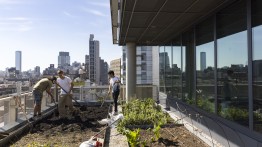Collaboration Takes Root
POSTED ON: October 17, 2024

“In nature,” Rachel Carson once observed, “nothing exists alone.” It’s a principle that holds even eight stories above Cooper Square, where students are cultivating an abundance of connections from a rooftop garden.
Members of the Cooper Union Garden Project went to work last fall pulling weeds from the overgrown beds of the Alumni Roof Terrace. Several weeks later, they were harvesting small crops of radishes, spinach, and herbs between rows of native perennials. Among the group’s organizers were Aerin Chavez and Denise Cholula, both 2024 School of Architecture graduates, and Brandon Bunt BSE’22 M.Eng’24. With funding from the 2023–2024 Cooper Union Grant Program, they began to revitalize the college garden as a community space for students from all three schools, supporting initiatives that range from urban horticulture workshops to reducing food waste to utilizing the garden as a testbed for innovation.
“It is a shared space, so it’s important to get a lot of people’s input and make sure it’s not just one person making decisions,” explains Cholula. That collaborative ethic is key to the Garden Project’s cross-disciplinary appeal. According to Chavez, creating opportunities to learn about soil composition and planting techniques has encouraged others at Cooper to roll up their sleeves and get involved: “We reached out to local community gardens and planned workshops because we want people to feel like they have the knowledge to help out and grow things.”
It was serendipity, however, that brought the Garden Project’s leaders together. In early 2023, Chavez and Cholula drew up a proposal to, in their words, “unlock the full potential of the Cooper Union Garden to become a space of research and collaboration” and submitted it to the Cooper Union Grant Program. The program, administered by the Office of the President, funds student, faculty, and staff projects that reflect the college’s strategic priorities. Chavez and Cholula were unaware at the time that Bunt, who was leading a team in the school of engineering called MUDBUG (Multiuse Data Acquisition Bio Unit Group), had similar aspirations. He and his engineering teammates applied for a grant to transform the garden into a laboratory for sustainability-focused research.
“Application reviewers were impressed by both applications separately but surprised two proposed projects had such parallel goals and objectives,” says Charlotte Wessell, director of the Office of the President. “I reached out to see if they were amenable to putting together a joint, multidisciplinary application using the strengths of each team. They immediately responded and submitted a new proposal just a few weeks later. It was encouraging to see their enthusiasm when they learned about the opportunity for collaboration with other students.”
Joining forces was a mutually beneficial prospect for the two groups. They were united behind the idea that the garden could become a place for interacting with peers in other disciplines who have an interest in ecology or sustainable food practices. And it opened the doors to working together on design and engineering projects that complement their combined gardening efforts.
The focus of MUDBUG, for example, is to develop low-cost remote sensors that can be dropped in garden beds and wirelessly transmit data related to soil quality and environmental conditions. “Our main hurdle has been waterproofing everything,” Bunt says, noting that a few mechanical engineering students had recently finished molding a silicon seal that would allow them to leave the sensors in the garden around the clock. The team is now working out how to connect the sensor technology to an irrigation control valve, effectively automating the garden’s watering system.
Irrigation is just one of the steep learning curves that come with growing plants on the roof of a college. “A lot of gardening resources don’t take into account being eight stories up in an urban environment,” Bunt says. Replenishing the garden’s soil, which dries out and gets periodically blown away by the wind because of the roof terrace’s elevation, was one of the first challenges the students tackled using funds from the grant. In February, the Garden Project formally launched a composting initiative in the Residence Hall with help from Athena Abadilla, director of residential life and community development. They devised a system for a steady supply of food scraps in the roof terrace’s three-bin system and tumbler to yield enough nutrient-rich compost to maintain the soil structure.
Ensuring continuity in tending the garden is another concern. “A garden needs continuous care, so it requires people to be there all the time,” says Cholula. Before being revived last fall, the beds had fallen into neglect. “We talked to some students who worked on the garden in past years before they graduated, but there was no formal knowledge transfer,” Bunt explains. “We wanted to figure out how to document everything we’ve learned and centralize that information for future students.”
As they look ahead, returning members of the group are eager to experiment with new ideas. One ambition is to engineer a system for collecting waste heat from a mechanical room in 41 Cooper Square and circulate it through a water line to heat the garden beds, potentially as a senior project for engineering students. Another goal is to host a workshop on making natural plant dyes. The group has also expressed interest in building an apiary. Even amid all the projects and planning, the garden offers refuge from the stress of academic life. According to Bunt, students have found simple routines like emptying food scraps into the compost bin to be beneficial to their mental health. “It can be a really therapeutic way to start your day.”




